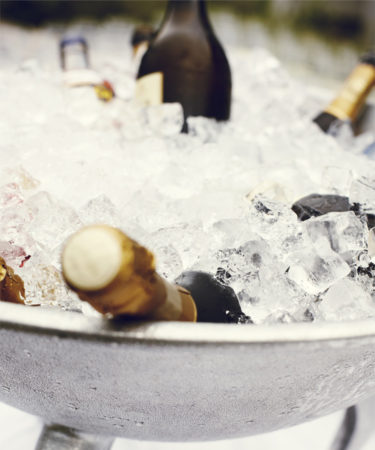Opening a bottle of bubbly definitely marks a celebration — and for many of us, the bottle is the celebration. But there’s no denying that opening said bottle is a bit of a commitment; as many of us know, that sparkling doesn’t hold up very long at all. So what to do when you just want to drink some bubbles by yourself, have a couple bottles in rotation, or have a casual glass to sip?
We talked to sparkling wine and Champagne experts to get their takes on how to keep the bubbles from falling flat over time. The biggest takeaway? Temperature. Read on for more dos and don’ts for keeping Champagne fresh in the fridge.
1. Store Champagne properly.
You can affect how long the bubbles last by how your bottle was stored in the first place. “No one is a fan of shrinkage!” says Marvina S. Robinson, founder of Stuyvesant Champagne, who recommends storing bottles horizontally (at a temperature of 50 to 55 degrees Fahrenheit) to keep the cork moist (and less likely to shrink), and your bubbly, well, full of bubbles. “I also recommend storing Champagne on its side to maximize quality,” says Didier Mariotti, Veuve Clicquot chef de caves (a.k.a. cellar master). “This keeps the cork from drying out and shrinking, which ultimately allows air to get in the bottle prior to even popping the cork.”
2. Keep the bottle cold.
It may seem like common sense, but it bears repeating: Temperature variation can cause the loss of carbonation. “I find that keeping it thoroughly chilled goes a long way,” says Lauren Kopit, winemaker at Sterling Vineyards. “To keep the bubbles livelier over the course of serving the wine, the most critical issue is to keep the bottle cold,” says Mary Ewing-Mulligan, International Wine Center President and Master of Wine. “At a cold temperature the CO2 remains dissolved in the liquid longer, while at warmer temperatures oxygen can interact with the wine and the CO2 decreases. Either keep the bottle in an ice bucket, or return it to the fridge between pourings.”
3. Don’t freeze your bottle for a quick flash of cool.
Avoid bursting bubbles by serving it cold, but do not freeze your bottle, says Robinson. (Yes, even if you’re in a time crunch.) “Champagne should be served between 47 and 50 degrees F., but don’t freeze it, or the glasses. Doing so will burst those tiny bubbles, and that’s not any fun at all.”
Open the bottle carefully. You want to open the bottle as gently as possible (with a sigh, rather than a pop) so that the effervescence isn’t lost as foam, says Ewing-Mulligan.
4. Choose a quality Champagne stopper.
Every expert here recommends investing in a Champagne stopper. A quality Champagne stopper is your best friend to keep bubbles in the bottle, as a regular wine stopper just will not do,” says Robinson. She suggests the MiTBA Champagne Stopper, or this rose gold OWO version. The dual-sided wings of these styles of stoppers can help create more pressure and a tighter seal, she says. (VinePair also sells a Heavyweight Champagne Stopper, which is a staff and reader favorite.)
Waiting for your stopper to arrive, forgot it when visiting a friend, or a slew of other reasons why you may not have one? “If you don’t have one available, you can put a metal spoon on its top,” says Ed McCarthy, author of “Champagne for Dummies,” who recommends doing so the instant you stop pouring. (He admits it’s not as good a stopper, but it’ll do in a pinch.)
5. Drink it.
No, really — it’s necessary that Champagne and sparkling wine are consumed in a short amount of time. Most experts say finishing it the next day is ideal, but up to three or four days, stored in the fridge with a stopper, will be fine. Typically, the wine is still enjoyable in this time frame, says McCarthy, “but the wine will be tamer and less exuberant than when you first opened it.” Any longer, and the structure of the wine can be affected.
Bonus tip: Eat your bubbles.
If all else fails (or say you opened three bottles for a virtual tasting and couldn’t finish them all), Robinson recommends using the extra fizz for Champagne cupcakes or other recipes that call for leftover wine.
